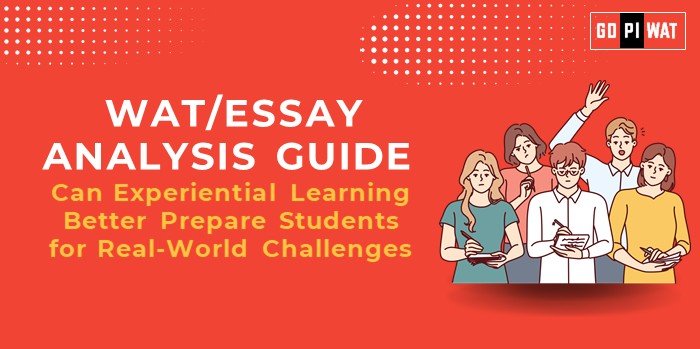📋 WAT/Essay Guide: Can Experiential Learning Better Prepare Students for Real-World Challenges?
🌟 Understanding Experiential Learning’s Importance
Experiential learning redefines education by emphasizing practical application over theoretical memorization. In the context of global education trends, it resonates strongly with the goals of modern B-schools.
📝 Effective Planning and Writing
Planning: 5 minutes | Writing: 20 minutes | Review: 5 minutes
💡 Introduction Techniques for Essays
1. Contrast Introduction: “Traditional learning methods focus on knowledge absorption, but experiential learning fosters knowledge application, bridging academic theory with industry practice.”
2. Solution-Based Introduction: “Experiential learning addresses the critical skill gaps employers identify in traditional graduates, offering a pragmatic alternative.”
📚 Structuring the Essay Body
- 📝 Paragraph 1: Achievements
Discuss examples like IIM Ahmedabad’s Rural Immersion Programs or MIT’s Action Labs. - ⚖️ Paragraph 2: Challenges with Comparative Analysis
Mention barriers such as high costs and resource constraints, using Finland and USA as benchmarks. - 🔮 Paragraph 3: Future Outlook
Recommend initiatives like public-private partnerships and leveraging technology for scalable experiential learning.
🔗 Concluding Effectively
1. Balanced Conclusion: “Experiential learning offers a promising path to align education with industry needs but requires a focused strategy for inclusivity and scalability.”
2. Global Perspective Conclusion: “With global adoption rising, India can learn from established models in Finland and the USA to build a robust experiential education system.”
🌱 Recommendations for Sustainable Progress
- 🤝 Encourage industry-academia partnerships.
- 👩🏫 Integrate experiential methods into teacher training.
- 💰 Promote funding models for underprivileged institutions.
✍️ Sample Short Essays
1. Balanced Perspective:
“Experiential learning bridges theory and practice, but achieving standardization and accessibility remains a challenge.”
2. Solution-Oriented:
“Adopting experiential methods is key to overcoming employability gaps, especially through scalable and inclusive innovations.”
3. Global Comparison:
“While Finland excels in holistic experiential education, India must focus on building robust infrastructure to emulate such success.”


